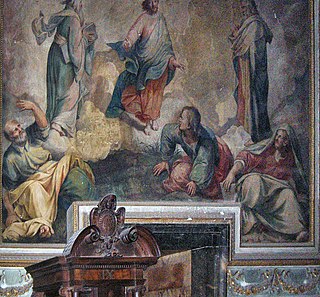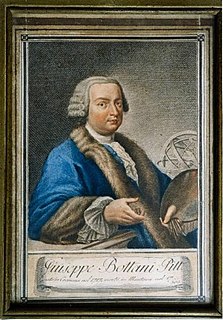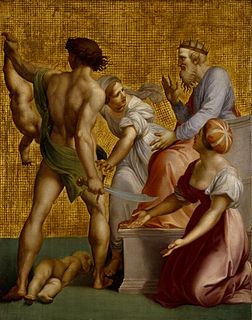Related Research Articles

Francesco Bartolozzi was an Italian engraver, whose most productive period was spent in London. He is noted for popularizing the "crayon" method of engraving.

Giovanni Battista Piazzetta was an Italian Rococo painter of religious subjects and genre scenes.

Francesco Beccaruzzi was an Italian painter of the Renaissance era, active near his hometown of Conegliano and in the neighborhood of Treviso. He was influenced by both Il Pordenone and later Titian. He painted Saint Francis receiving stigmata (1545) from Conegliano, but now in the Gallerie dell'Accademia in Venice.
Sebastiano Bombelli was an Italian painter, mainly active in Venice, during the Baroque period.

Antonio Bellucci was an Italian soldier who became a painter of the Rococo period and was best known for his work in England, Germany, and Austria. He was one of the many Venetian-trained artists of his time, including Ricci, Tiepolo, Amigoni, and others, who sought commissions north of Italy, providing patrons with the then-popular Italianate grand-manner frescoes for private palaces.

Mario Balassi (1604–1667) was an Italian painter of the Baroque period, active in Florence and Rome.
Jacopo Bambini (1582–1629) was an Italian painter of the Baroque period, active mainly in Ferrara.

Natale Bonifacio Natale Bonifacio de Sebenico where he was born and died) was a producer of engravings and woodcuts in Rome, where he lived and worked for most of his life. His plates are principally etchings. In 1590, he engraved for a book composed by Domenico Fontana, architect to Pope Sixtus V, concerning the laborious engineering of the moving and erection of the Vatican obelisks.

Durante Alberti was an Italian painter of the late-Renaissance period.
Giovanni Francesco Cassana (1611–1691) was an Italian painter of the Baroque period, active mainly in Genoa.

Tommaso Aldrovandini was an Italian painter of the Baroque period. He mainly painted perspective views and architectural subjects (quadratura), in which the figures were painted by Marcantonio Franceschini and Carlo Cignani. He decorated churches, palaces, and theaters in Forlì, Verona, Venice, Parma, Turin, Ferrara, and Genoa, and especially in his native Bologna. Among his pupils was Giovanni Benedetto Paolazzi.
Alessandro Badiale (1626–1671) was an Italian painter and engraver of the Baroque period, active in Bologna. He was a pupil of Flaminio Torre. Among his etchings are prints of Virgin seated with the Infant Jesus, between St. Philip Neri and St. Anthony of Padua, a Deposition and a Holy Family after Flaminio Torre. He also made a Madonna with Child, who holds a cross and an apple after Cignani.
Anton Giuseppe Barbazza was an Italian painter and engraver of the Baroque period. He was born in Rome, moved to Bologna, and in 1771 moved to Spain. In Rome, he had engraved the prints for Francesco Bianchini's L'istoria universale provata coi monumenti, published first in 1697 and reissued in 1747.

Giuseppe Bottani was an Italian painter active in the Baroque period.

Simone Brentana was an Italian painter of the Baroque period, active in Verona. He was born in Venice to Domenico Brentana, but became orphaned by age nine. After a prolonged desultory education in various fields including music, he trained as a painter in Venice with Pietro Negri, frequenting the Accademia di Belle Arti, moving in 1685 to Verona, where most of his paintings are located.

Giuseppe Cades was an Italian sculptor, painter, and engraver.
Fabio Berardi (1728–1788) was an Italian engraver of the Baroque period, active in Tuscany. He was born in Siena. He went to Venice when young, and trained under Joseph Wagner. Among other works, he engraved in 1767 a booklet of pictures about the life of emperor Francis I. He also engraved the following:

Martino Rota, also Martin Rota and Martin Rota Kolunić was an artist, now mainly known for his printmaking, from Dalmatia.

Antonio Baratti was an Italian engraver, etcher and printmaker.
Mauro Aldrovandini (1649–1680) was an Italian painter of the Baroque period. While he was most active in Bologna, and some claim he was native to the city, others claim he was born in Rovigo. He mainly painted perspective views and architectural subjects (quadratura) in private houses and for theaters.
References
- ↑ Ticozzi, Stefano (1830). Dizionario degli architetti, scultori, pittori, intagliatori in rame ed in pietra, coniatori di medaglie, musaicisti, niellatori, intarsiatori d'ogni etá e d'ogni nazione (Volume 1). Milan: Gaetano Schiepatti. p. 113.
- ↑ Bryan, Michael (1886). Robert Edmund Graves (ed.). Dictionary of Painters and Engravers, Biographical and Critical. Vol. I: A-K. London: George Bell and Sons. p. 84.